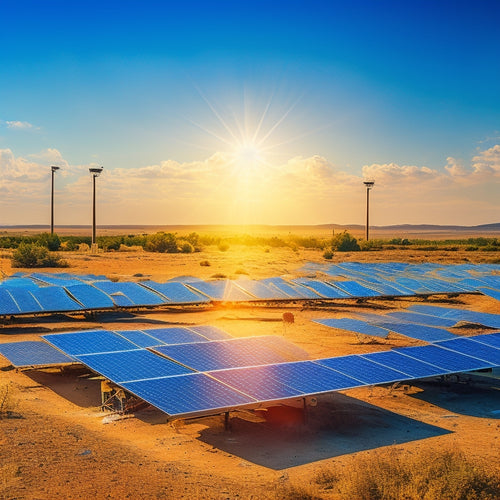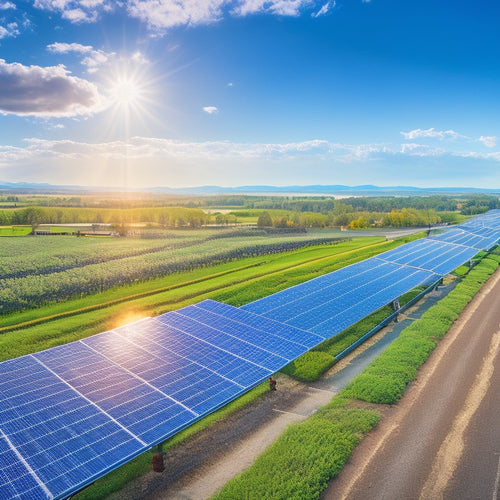
10 Essential Steps for DIY Solar Panel Kit Installation
Share
You're taking the first step towards renewable energy independence by embracing DIY solar panel kits, which promise significant energy cost savings and a reduced carbon footprint. Before you start, verify you've assessed your roof's shading, choosing a spot with minimal obstructions. Next, select high-efficiency monocrystalline silicon cells, as they outperform polycrystalline options. Then, conduct an energy audit to identify areas of inefficiency and evaluate your roof's layout, pitch, and installation angle. Properly size your solar panel kit and battery storage to meet your energy needs, and understand the importance of quality control in silicon cells. Now that you've got the basics covered, it's time to explore the finer details that'll maximize your system's performance.
At a Glance
- Conduct an energy audit to identify inefficiencies and opportunities for consumption reduction before installing a DIY solar panel kit.
- Ensure proper sizing of the solar panel kit and battery storage to meet energy needs, maximize system efficiency, and optimize savings.
- Assess roof layout, pitch, and installation angle for optimal placement, and analyze shading impact on solar panel performance.
- Choose high-quality monocrystalline silicon cells with high-purity silicon sourcing, and rigorous testing and inspection before packaging.
- Ensure secure fastening methods, adequate thermal management, and proper alignment of solar panels for effective sunlight capture and maximum energy harvesting.
Renewable Energy Independence Awaits
You're on the cusp of achieving renewable energy independence, and with it, significant energy cost savings that'll add up over time.
By installing a DIY solar panel kit, you'll be reducing your reliance on the grid and generating clean energy that's kind to your wallet and the environment.
With government incentives like tax credits lowering the overall cost, your investment will pay off even faster.
As you shift towards an off-grid lifestyle, you'll enjoy the freedom and security that comes with being in control of your own energy needs, contributing to a cleaner environment through sustainable lifestyle choices and carbon offset strategies.
Energy Cost Savings
By utilizing the power of solar energy, homeowners can greatly reduce their reliance on the grid and slash their energy bills. This translates to significant cost savings over time, making your investment in a DIY solar panel kit a wise one.
To understand the extent of these savings, it's crucial to conduct a thorough cost analysis. First, assess your current energy consumption and calculate your average monthly energy expenditure.
Next, determine the energy efficiency of your solar panel kit, considering factors like panel wattage, system size, and local solar irradiance. By doing so, you'll be able to estimate the amount of energy your system will produce and the corresponding reduction in your energy bills.
According to the US Department of Energy, a typical residential solar panel system can save homeowners between $400 and $1,000 per year on their energy bills. Over the system's 25-year lifespan, these savings can add up to $10,000 or more.
With a DIY solar panel kit, you can achieve energy independence and reap the financial rewards that come with it.
Going Off Grid
Achieving renewable energy independence is the ultimate goal for many homeowners who invest in DIY solar panel kits. You're not just looking to reduce your energy bills; you want to break free from the grid and enjoy the freedom that comes with generating your own clean energy.
Going off grid means you're no longer reliant on the utility company, and you're in control of your energy needs.
To attain off grid living, you'll need to take into account solar battery storage. This allows you to store excess energy generated by your solar panels during the day for use at night or during power outages.
A well-designed solar battery storage system guarantees you have a reliable source of energy, even when the grid is down.
When you go off grid, you'll need to size your solar panel kit and battery storage system to meet your energy needs. This requires careful planning and thought regarding your energy usage patterns.
Save Money on Electricity
By installing a DIY solar panel kit, you'll greatly lower your electricity bill and reduce your energy costs.
With solar power, you'll generate free electricity during the day, reducing your reliance on the grid and slashing your monthly payments. As you produce more power, you'll see a direct decrease in your energy expenditure, putting more money back in your pocket.
Lower Your Bill
With a DIY solar panel kit, you can slash up to 50% off your electricity bill, depending on your current energy consumption and the size of your solar panel system. By utilizing the power of the sun, you'll reduce your reliance on the grid, and your wallet will thank you.
To maximize your savings, take advantage of solar incentives offered by your state or local government. These incentives can greatly offset the upfront cost of your DIY solar panel kit, making it even more affordable.
Before you start installing your solar panels, confirm you have the necessary installation permits. These permits guarantee that your solar panel system meets local building codes and safety standards, giving you peace of mind.
By following the necessary steps and taking advantage of available incentives, you'll be on your way to enjoying lower electricity bills and a reduced carbon footprint.
With your DIY solar panel kit, you'll be one step closer to energy independence and a more sustainable future.
Reduce Energy Costs
Through careful planning and system sizing, you can optimize your DIY solar panel kit to maximize energy cost savings. By conducting an energy audit, you'll identify areas of inefficiency in your home and pinpoint opportunities to reduce energy consumption.
This audit will help you determine the ideal system size and configuration for your specific needs, ensuring you generate enough electricity to offset your utility bills.
To further reduce energy costs, investigate utility incentives and rebates offered in your area. Many utilities provide discounts or credits for solar-powered homes, which can greatly lower your electricity bills.
Additionally, you may be eligible for federal and state tax credits, which can help offset the initial investment in your DIY solar panel kit. By taking advantage of these incentives, you'll realize considerable long-term savings on your energy costs.
Monocrystalline Silicon Cells
You're likely familiar with the term "monocrystalline silicon cells" in the realm of DIY solar panel kits, but it's essential to understand the significance of cell efficiency in these systems.
The quality of the silicon used in monocrystalline cells directly impacts their ability to convert sunlight into electricity, making it a vital factor in your solar panel's overall performance.
When selecting high-efficiency monocrystalline cells, consider battery types and selection for ideal energy storage and conversion.
By doing so, you'll be able to maximize your energy output and minimize your carbon footprint.
Cell Efficiency Matters
Efficiency is the unsung hero of solar panel performance, and monocrystalline silicon cells are the epitome of this virtue. When you opt for a DIY solar panel kit, you're looking for ideal cell performance. Monocrystalline silicon cells boast an impressive efficiency rate of 15-20%, considerably higher than their polycrystalline counterparts. This superior efficiency translates to more power output per unit area, making them an ideal choice for your solar panel installation.
Recent technology advancements have further enhanced cell performance. Improved manufacturing techniques and research have led to the development of high-efficiency cells with reduced recombination losses.
These advancements enable you to utilize more energy from the sun, reducing your reliance on traditional power sources and bringing you closer to energy independence. As you install your DIY solar panel kit, you can rest assured that monocrystalline silicon cells will provide you with reliable and efficient energy production, maximizing your return on investment and creating a path to a more sustainable future.
Silicon Quality Control
When selecting a DIY solar panel kit, the quality of monocrystalline silicon cells can make or break your solar panel's performance. You want to guarantee the silicon cells in your kit are of high quality to maximize energy production.
To achieve this, you need to scrutinize the silicon sourcing and quality control processes of the manufacturer. Look for manufacturers that source their silicon from reputable suppliers with a proven track record of producing high-purity silicon. The purity of silicon directly affects the cell's efficiency, so it's essential to get it right.
Additionally, check if the manufacturer has a strong quality control process in place, including rigorous testing and inspection of the cells before they're packaged into the DIY kit. A reliable manufacturer will provide you with detailed specifications of their silicon cells, including the purity level, efficiency rate, and fill factor.
Don't settle for anything less, as subpar silicon cells can lead to reduced energy output, decreased lifespan, and increased maintenance costs. By doing your due diligence, you'll end up with a DIY solar panel kit that meets your energy needs and provides you with the freedom you desire.
Assess Your Roof's Shading
You'll need to identify roof obstructions that could cast shadows on your solar panels, such as skylights, vents, and chimneys.
To determine the shading pattern, observe your roof during different times of the day and year to identify areas that receive direct sunlight and those that are partially shaded.
Conducting energy audits energy efficiency can also help you pinpoint areas of energy inefficiency, which can be addressed before installing your solar panels.
Roof Obstructions to Check
As you prepare to install your DIY solar panel kit, surveying your roof's obstructions is vital to evaluate its shading. This step guarantees you maximize energy production by identifying areas that could reduce your solar panels' efficiency. Start by examining your roof's layout, considering the roof pitch and installation angle to determine the best placement for your solar panels.
| Obstruction Type | Impact on Shading |
|---|---|
| Chimneys | Can cast shadows on solar panels, especially during winter months |
| Vents | May cause partial shading, depending on their size and location |
| Skylights | Can create shading patterns, affecting solar panel performance |
Take note of other obstructions, such as satellite dishes, roof antennas, or nearby trees, which can also impact your solar panels' energy output. By carefully evaluating these obstructions, you can optimize your solar panel kit's installation and guarantee maximum energy production. Remember, a well-planned installation is vital to achieving energy independence and reducing your reliance on the grid.
Shading Pattern Analysis
Now that you've identified potential roof obstructions, it's time to analyze the shading patterns they create. This is vital in determining the shading impact on your solar panel kit's performance.
To do this, observe your roof during different times of the day and year to understand how shadows fall on the area. Take note of the duration and intensity of shading, as well as the direction it comes from. This information will help you identify areas that receive full sun, partial shade, or full shade.
Next, use this data to develop shading solutions. For instance, you might need to trim trees or remove obstructions to minimize shading.
Alternatively, you could consider using specialized equipment like solar panels with built-in shading mitigation features or micro-inverters that optimize energy production despite shading.
Higher Energy Conversion Rate
You're looking to maximize your solar panel kit's energy conversion rate, and that means selecting cells with higher efficiency ratings.
Higher efficiency cells convert more sunlight into usable electricity, reducing energy waste and increasing your overall energy yield.
Higher Efficiency Cells
Within the domain of DIY solar panel kits, incorporating higher efficiency cells can greatly enhance your system's energy conversion rate. By choosing cells with improved photovoltaic properties, you'll generate more power from the same amount of sunlight. This translates to a smaller footprint for your solar array, reduced installation costs, and a faster return on investment.
When evaluating higher efficiency cells, consider factors beyond just their conversion rate. Cell durability, for instance, is essential in withstanding environmental stresses and ensuring a long system lifespan. Look for cells with sturdy manufacturing processes and rigorous testing standards.
Additionally, pay attention to installation techniques that can impact cell performance. Proper alignment, secure fastening, and adequate thermal management are all vital in realizing the full potential of your higher efficiency cells. By combining these factors, you'll reveal the full benefits of higher efficiency cells and maximize your DIY solar panel kit's energy harvesting capabilities.
Frequently Asked Questions
Do I Need a Permit to Install a DIY Solar Panel Kit?
You'll need to check with your local government to determine if a permit is required for your DIY solar panel kit installation, as local regulations and installation guidelines vary, but don't worry, it's a straightforward process that'll guarantee your system meets safety standards.
Can I Install Solar Panels on a Metal Roof?
You can install solar panels on a metal roof, leveraging its advantages like durability and water-tightness; however, you'll need to contemplate specialized installation considerations, such as clamping systems and waterproofing, to guarantee a secure and watertight seal.
How Often Should I Clean My Solar Panels?
You'll want to clean your solar panels every 6-12 months to guarantee peak energy production; use soft brushes, mild soap, and distilled water to avoid scratching the panels, and consider investing in automated cleaning systems for low-maintenance solar panel upkeep.
Are DIY Solar Panel Kits Compatible With All Inverters?
As you begin on utilizing the sun's power, you're likely wondering if DIY solar panel kits work well with all inverters. Rest assured, most kits are designed to be inverter-agnostic, but it's essential you double-check compatibility before DIY installation to guarantee seamless energy collection.
Can I Expand My Solar Panel Kit in the Future?
You'll be relieved to know you can easily expand your solar panel kit in the future, thanks to its inherent future scalability, allowing you to seamlessly add more panels for increased energy output and solar expansion whenever you need it.
Explore More
You've made it! With these 10 essential steps, you're ready to utilize the power of the sun and slash your electricity bills. Did you know that a typical residential solar panel system can save you up to $500 per year on your energy costs? That's a significant chunk of change! Now, get out there and start installing - your renewable energy independence awaits!
Related Posts
-

Solar Phone Chargers for Camping Essentials
Solar phone chargers are must-haves for your camping essentials, allowing you to stay connected while enjoying nature...
-

What Happens Without a Charge Controller in Solar Panels
Without a charge controller in your solar panel system, you risk overheating batteries due to overcharging, which can...
-

Applications of Photovoltaic Systems
Photovoltaic systems are versatile, converting sunlight into electricity for various applications. You can use them i...


